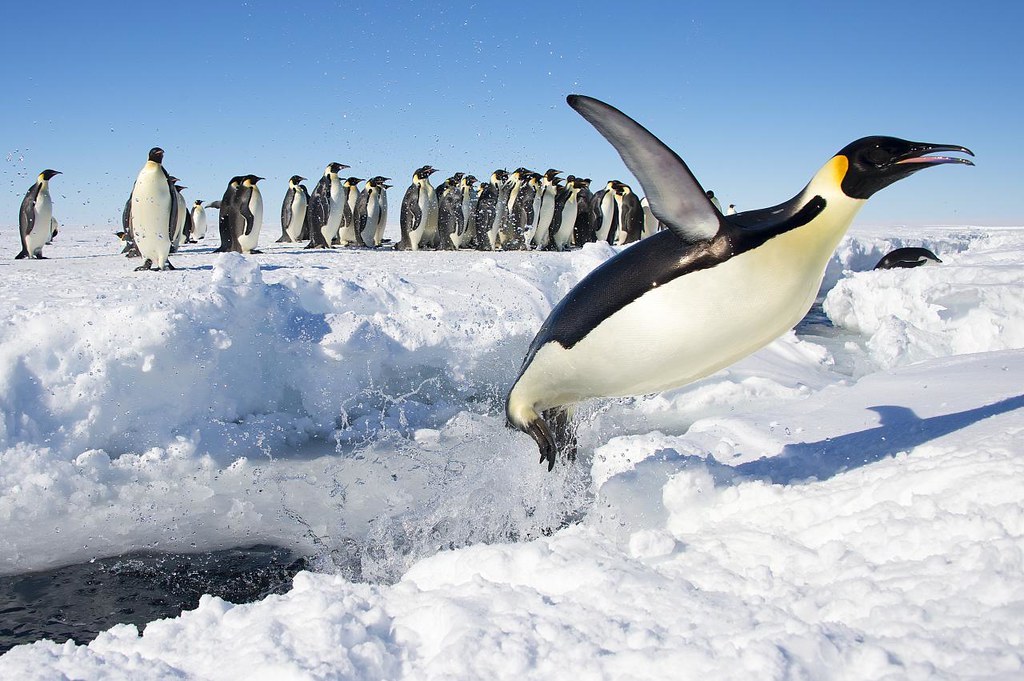7 Facts That Prove Emperor Penguins Rule
Meet the world’s largest penguins

The incredibly chilly, ice-laden waters of the Antarctic may be unbearable for some members of the animal kingdom. But when it comes to this freezing polar region, emperor penguins (Aptenodytes forsteri) say, “There’s no place like home!”
These flightless birds, reminiscent of waddling tuxedo-laden gentlemen with beaks, are exclusively found on the ice shelves of Antarctica. But that’s not all that makes them special. Emperor penguins are the largest of the world’s 18 identified penguin species alive today, standing up to four feet tall and weighing up to 100 pounds! With two layers of feathers and sturdy fat reserves, emperor penguins can conserve as much heat as possible as they brave the frigid temperatures of their home.

While their size is certainly impressive by today’s standards, check out the extinct Palaeeudyptes klekowskii, often referred to as “mega penguins.” These gigantic ancestors of emperor penguins lived between 37 and 40 million years ago and clocked in at almost six feet tall!
The height of modern emperor penguins isn’t the only thing that makes them so remarkable, though. These penguins are truly Antarctic athletes, with special adaptations that help them make the most of their extreme native ecosystem. They have incredibly dense bones that help them move like torpedoes through the sea, with most diving up to around 600 feet below the surface. The world record for an observed emperor penguin dive is a jaw-dropping 1,700 feet!
Their bodies are specially designed for more than just the water, though. When emperor penguins want to leave the water and return to the ice shelves, they’ll plummet deep into the ocean, ramp themselves up and then race toward the closest exit hole in the ice. As they do so, they carefully move their feathers around, releasing bubbles that assist in their exit plan. As they leave the water and enter the air, they burst through the ice holes quickly and powerfully, helping them to skirt past sneaky leopard seals that may be hunting around the perimeter of the ice.

One last thing that’s mildly hilarious to watch but truly an effective behavioral adaptation for emperor penguins is a movement known as “tobogganing.” And yes, if you know what a toboggan is, you can probably already picture what this looks like! Though agile, these penguins do live on incredibly slippery surfaces. So, when they need to get around quickly (especially when traveling long distances to hunt), they’ll simply plop themselves on their stomachs and slide forward, using their wings and claws to propel themselves along the ice.
I couldn’t share fun facts about emperor penguins without next mentioning the wild story of what child-rearing looks like for these creatures. When mating season arrives for emperor penguins, the courtship process can take a few weeks. Once a pair has bred, the female will lay a single egg … then she says “Ciao, dear!” Don’t worry, though: she’ll be back. She’s headed off to hunt for foods like krill, squid and fish such as Antarctic silverfish in order to provide for her little one. This departure, of course, leaves dad and baby penguin to spend some dedicated one-on-one time together.

When it comes to parenthood, there aren’t many fathers you’ll find that are as dedicated as emperor penguin dads. When the mother penguin leaves, father penguins tuck the newly hatched egg on top of their feet beneath what’s called a brood pouch which provides cozy insulation for the still-developing baby penguin. Through fierce wind and icy storms, these determined dads will hold their eggs closely and guard them from the elements, even refusing to eat so the eggs receive constant warmth and protection. This becomes even more impressive with the fact that temperatures in this part of the world can drop below -50°F with wind speeds of up to 120mph.
It’s only when mama penguin returns from her hunt for food about two months later that papa penguin (who’s relied on stored body fat to remain alive this whole time) finally goes off to forage, eat and regain his strength. When this grand return of the mother emperor penguins occurs, those precious eggs are newly-hatched little ones … and they are hungry. For a while, they’ll stay close to mom and rely on regurgitated food from their mothers until they mature enough to hunt on their own.

All in all, emperor penguins’ amazing adaptations are among the countless examples of impeccable strength and teamwork in the animal kingdom. Colonies will come together in massive huddles surpassing 5,000 penguins, packing themselves in nice and tight to share as much body heat as possible. In a constant shuffle, the birds take turns braving the harsh outer perimeter of the group so that each member of the community gets some time in the warm center of the pack.
Whether regarding their magnificent physical and behavioral adaptations or their unwavering commitment to parenthood and rearing the next generation, one thing is for certain: Emperor penguins aren’t just the largest of penguins on Earth today—they’re also a species we can learn countless lessons from as we take on our own adventures in this journey of life.
Oh, and one more thing … remember when I said they have two layers of feathers to keep them warm? That includes a layer of feathers on their leg, so their ankles don’t get chilly. Talk about some serious leg warmers!
